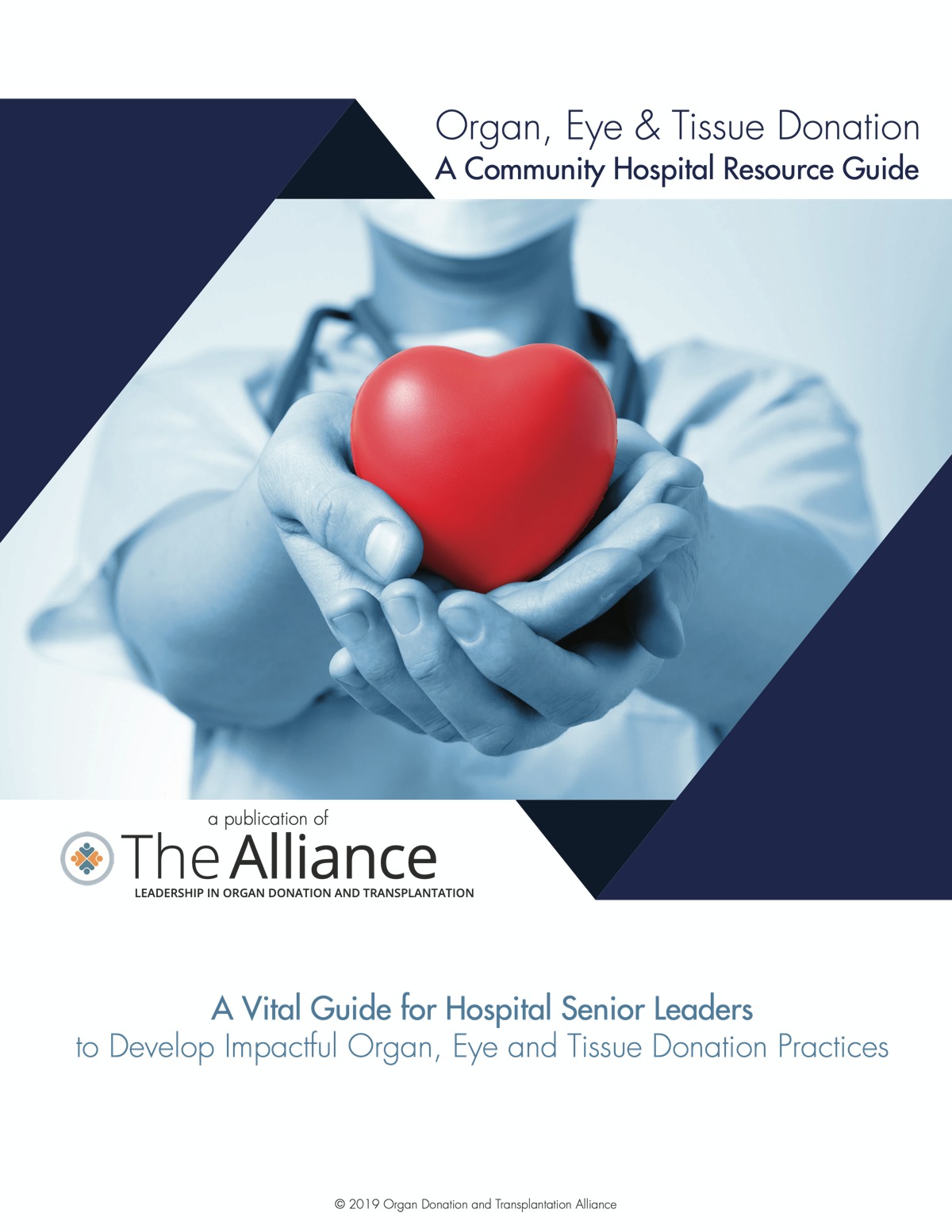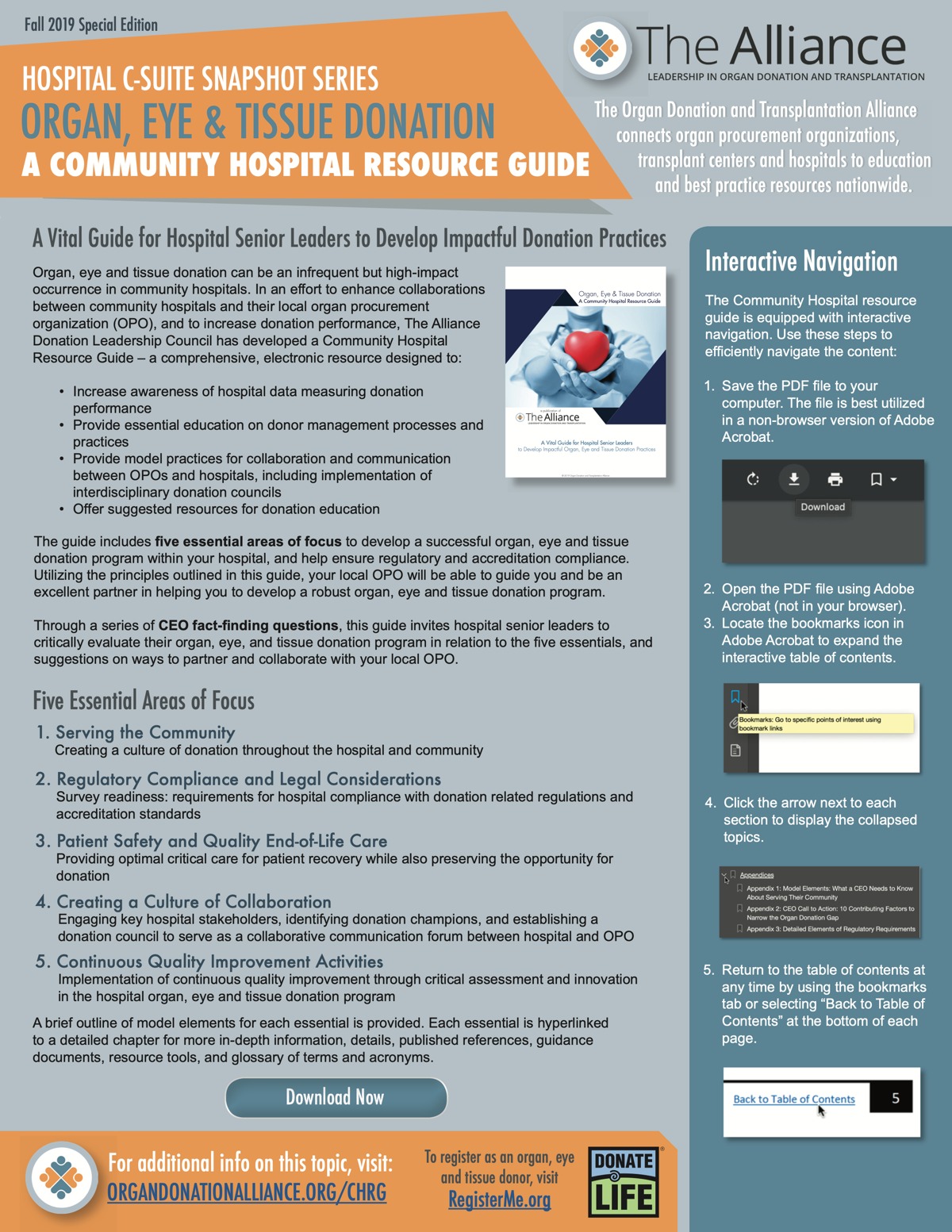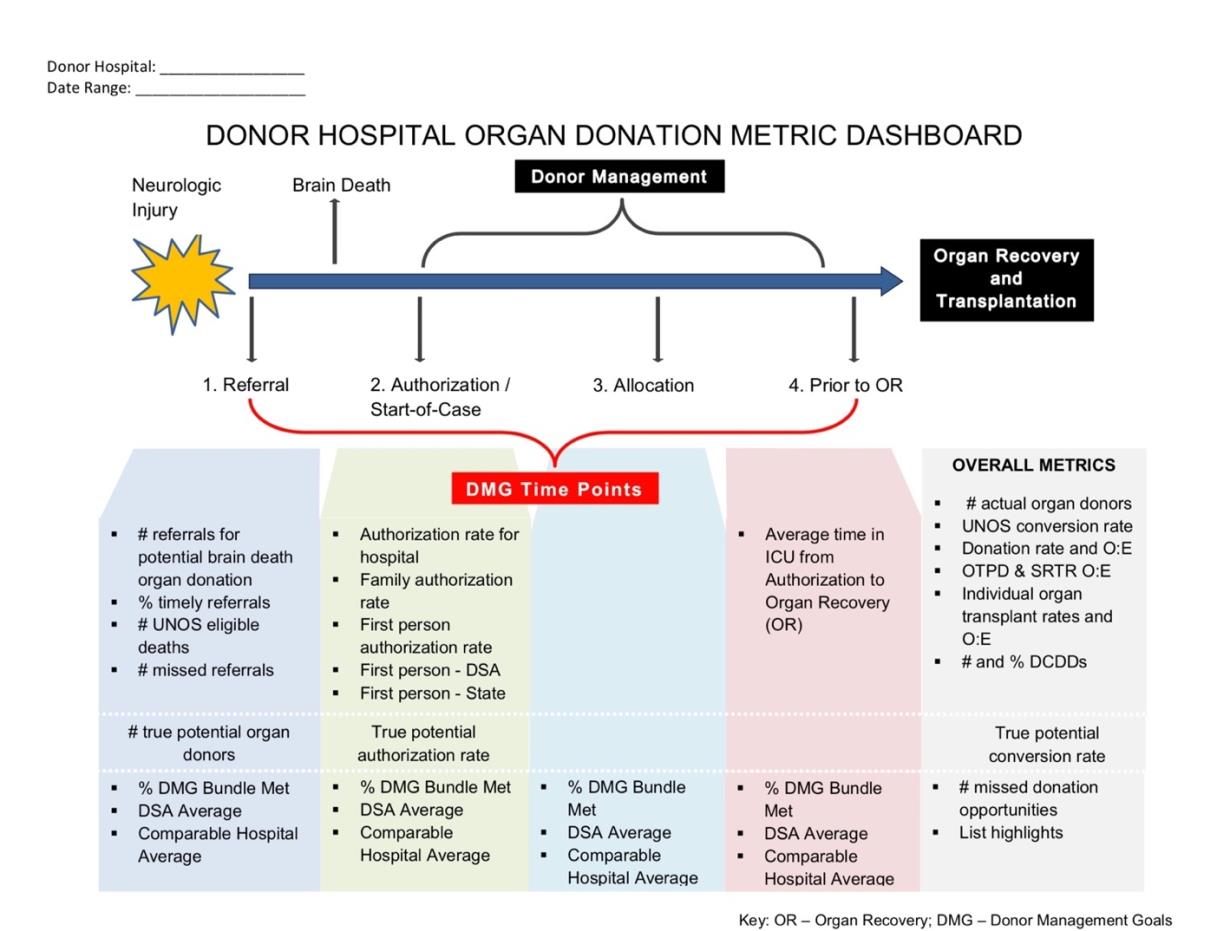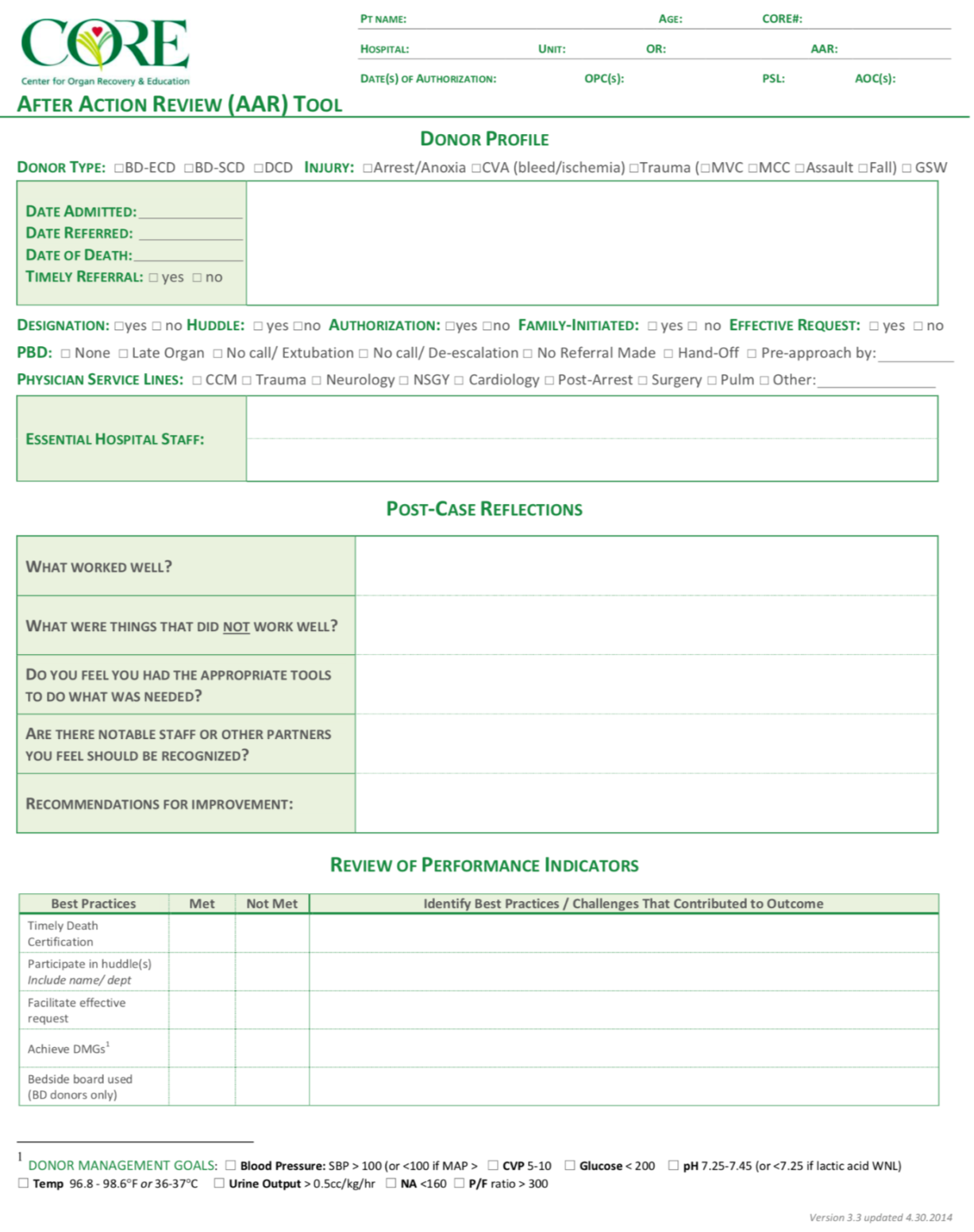Community Hospital
Resource Guide
A Vital Guide for Hospital Senior Leaders to Develop Impactful Organ, Eye and Tissue Donation Practices
Table of Contents
A Community Hospital Resource Guide
For linking to the Community Resource Toolbox, the Community Hospital Resource Guide and Transplant Quality Resources Guide and Tools, please use the following disclaimers:
Community Resource Toolbox Disclaimer:
The Community Resource Toolbox includes a variety of resources created, collected, and/or compiled by the Organ Donation and Transplantation Alliance. (Insert name of your organization) is neither affiliated with nor endorsed by the Alliance and claims no ownership in any of the Community Resource Toolbox materials. By clicking this link, you will be directed to the Alliance’s website located at https://www.organdonationalliance.org//resources/toolbox/.
Please use the Alliance logo on your website. Link here to locate and download a version of the logo that best suits your site:
Transplant Resource Guide (TRG) Disclaimer:
The Transplant Resource Guide (TRG) includes a variety of resources created, collected, and/or compiled by the Organ Donation and Transplantation Alliance. (Insert name of your organization) is neither affiliated with nor endorsed by the Alliance and claims no ownership in any of the Transplant Resource Guide (TRG) materials. By clicking this link, you will be directed to the Alliance’s website located at https://www.organdonationalliance.org/resources/transplant-resource-guide/.
Please use the Alliance logo on your website. Link here to locate and download a version of the logo that best suits your site:
Community Hospital Resource Guide Disclaimer:
The Community Hospital Resource Guide includes a variety of resources created, collected, and/or compiled by the Organ Donation and Transplantation Alliance. (Insert name of your organization) is neither affiliated with nor endorsed by the Alliance and claims no ownership in any of the Community Hospital Resource Guide materials. By clicking this link, you will be directed to the Alliance’s website located at https://www.organdonationalliance.org/resources/community-hospital-resource-guide/.
Please use the Alliance logo on your website. Link here to locate and download a version of the logo that best suits your site:
The Alliance Resource Section
ESSENTIAL 5
CONTINUOUS QUALITY IMPROVEMENT ACTIVITIES
This essential highlights strategies to implement a continuous quality improvement program through ongoing critical assessment, implementation of process improvement activities and hardwiring quality practices to drive improvement in the hospital’s organ, eye, and tissue donation program.
Fact Finding Questions CEOs May Ask of Their Senior Leadership:
- What is our hospital’s true potential conversion rate for organ donation?
- How do we align with national benchmarks?
- How do we compare to our peers?
- To improve our donation outcomes, have we conducted a quality assessment utilizing recognized quality tools such as Plan-Do-Study-Act (PDSA), Root Cause Analysis (RCA)?
Model Elements for High-Level Overview of Continuous Quality Improvement Activities
Detailed Components for High-Level Overview of Continuous Quality Improvement Activities
- Bi-annual meetings between the OPO and hospital senior leadership (Hospital Executive Insight Series)
- Ongoing quality assessment by donation council and quality team
- Loss of income by not referring (relate to income/CFO interest)
- Check to see how you compare with other hospitals in your Donation Service Area:
- Visit http://www.srtr.org.
- Click Organ Procurement Organization (OPO) Reports.
- Find your OPO.
- Download PDF Report.
- Locate Table “B2” to find your hospital’s data along with other hospitals in your community.
- Potential Organ Donor Timeline Dashboard [Appendix 26]
- Hospital Organ, Eye and Tissue Donation Dashboard
- After Action Review Form [Appendix 28]
DETAILED COMPONENTS OF CONTINUOUS QUALITY IMPROVEMENT ACTIVITIES
Federal and State governments, physicians, nurses, insurers, health plans, hospitals, accreditation organizations, and others have begun to address some of the significant quality problems in the United States healthcare system. One approach they have taken is to improve the ability to measure and report on the quality of care being delivered. The reporting of quality measures prompts a closer look at provider or health plan practices both as feedback for clinicians or as publicly available scorecards for consumers and purchasers to evaluate.
Quality Improvement consists of systematic and continuous activities that lead to measurable improvement in healthcare services and the health status of tangible patient groups. Quality healthcare is a high priority for the Department of Health and Human Services and the Centers of Medicare and Medicaid Services (CMS). CMS uses quality measures in its various quality initiatives. These quality initiatives assure quality healthcare for all Americans through accountability and public disclosure. Standardizing care means patients consistently receive the safest and most effective care for their conditions.
QUALITY IMPROVEMENT (QI) PROGRAM ACTIVITIES
The primary activities of the QI program should focus on donation outcome practices through monthly monitoring statistics. These monthly statistics should be available to the senior leadership as well as to all members of the Donation Committee. This data should play a focal point at the Donation Council Meetings. It should be a primary objective of every meeting to review this data. The data gathered and reviewed will help direct the committee’s duties as to assure that throughout your hospital, there is a consistency in the practice of organ/tissue recovery and family approaches. It supplies great revelation on gaps in education as well as systemic practices.
- Medical Record Review (MRR) of all deaths within your hospital monthly. In reviewing the records, you will track all the deaths within your hospital.
- There is the opportunity to divide information per hospital unit
- ICUs
- Emergency Departments
- Palliative Care Units
- There is the opportunity to divide information per hospital unit
- Within each record we can determine:
- Number of deaths referred / Number of deaths not referred
- Number of deaths not referred w/in 60 min of time of death (CMS)
- Missed Clinical Triggers collaboratively set by your hospital and OPO
- Location of Potential Organ Donors
- Your local OPO will should be a part of your Donation Committee and will provide donation related outcome of potential donors vs actual donors at your hospital. This information will also be shared with your hospital donation liaison.
- Potential vs. Actual Donors
- Donation after Brain Death / Donation after Circulatory Death Results
- Timeliness of Referral (asystolic and heart beating)
- Missed Referrals (asystolic and heart beating)
- Conversion Rate
- Organ
- Tissue
- Donation Outcome Details
- Authorization & Authorization Rate
- Registered /First Person Authorization
- Collaborative Donation Process
- Effective Request / Planned Donation Discussion
- Organ disposition
- Transplant; research; education; recovered, not transplanted
- Authorized, not recovered
- After Action Review (AAR) if indicated
- Authorization & Authorization Rate
- Potential vs. Actual Donors
- Measuring and sustaining outcome improvements in healthcare is always a priority. Your Organ Procurement Organization (OPO) dashboards, OPO Annual Strategic Plans (HSP), Death Record Reviews (DRR), Medical Record Reviews (MRR), After Action Reviews (AAR), GAP Analysis, used in tandem is a way to measure and sustain improvements in outcomes. Utilizing the scorecards in organ donation will allow you to look at an overview of the long-term goals and objectives of your hospital against the healthcare systems strategic outcomes. Along with this data the real time operational information of your industry can be captured in the in-depth Dashboard data.
- This data comparison would be in the form of data collected in the monthly distributed OPO Organ, Eye and Tissue Donation Dashboard
- Total Deaths
- Total Referrals
- Compliance Rate
- Organ Donation Outcomes
- Number of Appropriate Organ Approaches
- Authorization received for Organ Donation
- Potential Organ Donors
- Total Organ Donors
- Conversion Rates
- Number / % DCD Donors
- Number of Organs Transplanted
- Number of Organs Transplanted per Donor
- Tissue Donation Outcomes
- Potential tissue donors
- Approach and authorization for tissue donation
- Missed potential tissue donors
- Eligible tissue referrals
- Total tissue donors
- Conversion Rate
- Eye Donation Outcomes
- Potential eye donors
- Approach and authoriation for eye donation
- Missed potential eye donors
- Eligible eye referrals v. Total eye donors
- Conversion Rate
- The other data to then use to make comparisons is the Year to Date Summary looking at organ and tissue practices over that long-term setting. The report should reflect whether you are meeting the standards or below standards in all of these areas.
- This data comparison would be in the form of data collected in the monthly distributed OPO Organ, Eye and Tissue Donation Dashboard
- The effectiveness of your QI program should be evaluated through progress reports regarding the following topics:
- Tracking deviations from regulatory and accrediting organizations along with current policy and procedures that have been remediated using quality tools such as Root Cause Analysis (RCA) and Corrective and Preventative Actions Plans
- Member and practitioner satisfaction
- Utilization management
- Complaints and appeals
- Results of quality improvement studies








